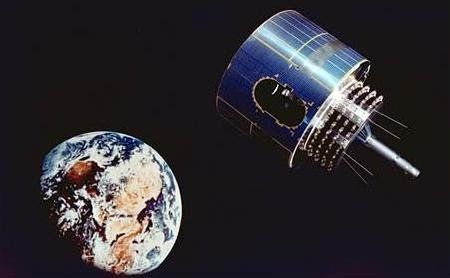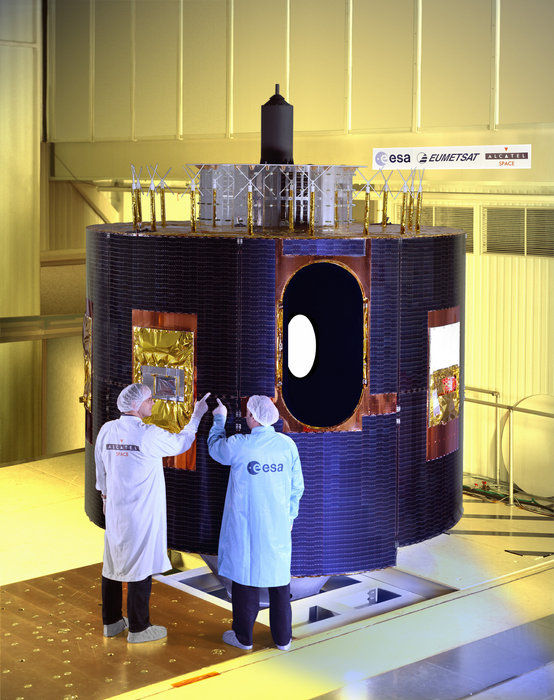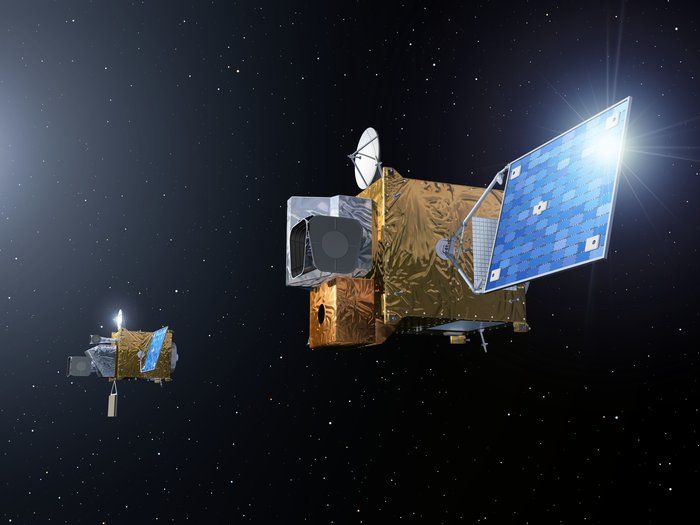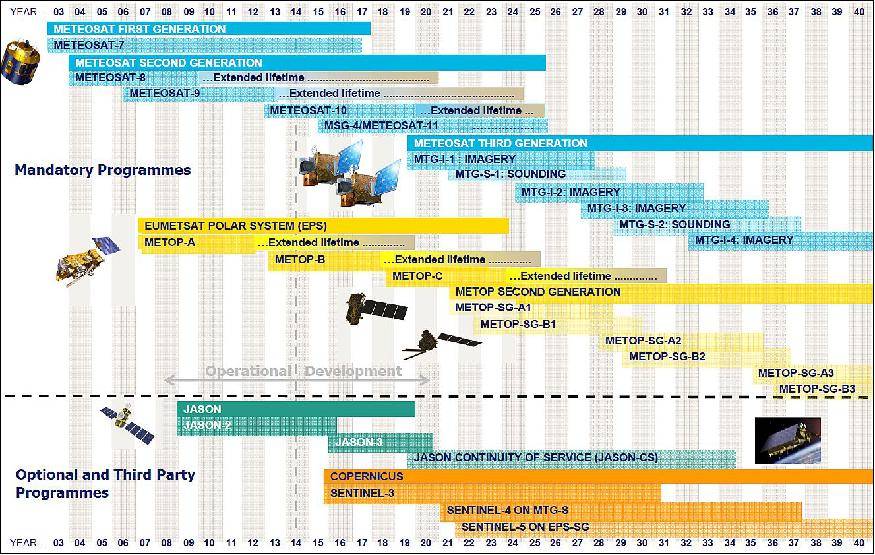Meteosat Program
The Meteosat program finds its origin in 1977 when the first prototype satellite was launched to explore the technologies needed to acquire meteorological data from Geostationary Orbit. Two more prototype satellites were launched in 1981 and 1988 before the first operational satellite, Meteosat-4, launched in 1989. As part of the Meteosat Operational Program, three satellites were launched followed by Meteosat-7 in 1997 as part of the Meteosat Transition Program that was implemented to bridge the gap between the first and second generation of Meteosat spacecraft by launching one improved first generation satellite.
Meteosat-7 remains in operation as of 2015, becoming the longest serving operational satellite in the history of EUMETSAT. MSG
The second Meteosat generation was initiated in 1993 with a two-year science definition program before instrument and satellite development began in 1995 under split funding by ESA and EUMETSAT with ESA responsible for the development of the first of the MSG satellite and EUMETSAT in charge of financing the three remaining satellites, providing the ground and data processing system and operating the satellites.
The first second generation Meteosat made its way into orbit in August 2002 and was to be followed by three more satellites to continue an operational continuity of Meteosat data for at least 16 years. MSG-2 launched in 2005 after the first second generation satellite had finished checkouts and proved all systems and instruments were providing the expected performance. MSG-3 launched in 2012 to become Meteosat-10 once its in-orbit checkout was complete.
Since 2013, the existing Meteosat constellation has entered a mode of operations in which the operational satellites share the labor – Meteosat-7 is stationed over the Indian Ocean, responsible for the acquisition of imagery of the Indian Ocean every 30 minutes and the relay of data from buoys in the Ocean in support of the Tsunami Warning System while Meteosat-8, 9 and 10 are stationed over Africa.
Meteosat-9 delivers rapid-scan data for Europe while Meteosat-10 is in charge of full-disk imaging of Earth and Meteosat-8 is in a backup mode for either spacecraft 9 or 10. Once fully commissioned in orbit, MSG-4 (then to be re-named Meteosat-11) will be placed in a storage mode to take over from one of the older spacecraft once their performance starts degrading.
The Meteosat Second Generation program was conceptualized as a two-satellite operational service like its predecessor. Only one satellite is required to provide the core data to fulfill the objectives of the Meteosat program. MSG delivers to the user community continuity of data services of the first Meteosat generation, but with significantly enhanced services and data products. Data delivered by MSG is used in support of weather nowcasting, very short and short-range forecasting, numerical weather forecasting models and climate monitoring over Europe and Africa.
MTG is the next-generation European operational geostationary meteorological satellite system – a collaborative EUMETSAT/ESA program.
Meteosat Third Generation, image ESA
<span lang="en">Extended Information </span>
Meteosat Second Generation MSG
The MSG satellites are cylindrical spacecraft that use spin stabilization, rotating their bodies at 100 revolutions per minute to remain in a stable orientation, not requiring active attitude control systems. The spacecraft body is a cylindrical solar drum that measures 3.22 meters in diameter and 3.74 meters in length with a body height of 2.4 meters using a stepped cylinder design. The MSG satellite has a mass of around two metric tons.
The MSG satellite structure consists of two main parts, the 192-Kilogram primary structure that provides the support of the satellite payload and the various subsystems and electronics boxes, and the Secondary Support Structure weighing 27.5 Kilograms and supporting the Unified Propulsion System and the Electrical Power System. The Primary Structure itself is comprised of the Service Module Structure hosting the payloads and majority of the subsystems, and an Antenna Platform hosting the communications antenna.
Meteosat Second Generation is operated by EUMETSAT and provides almost continuous images to meteorologists and researchers in Europe and around the world. It incorporates significant enhancements in frequency and resolution to the previous generation of Meteosat. MSG measures in 12 spectral channels (compared to only 3 on the previous Meteosat) and records data in a 15 minute cycle (30 minutes on the previous Meteosat). The resolution of the high-resolution visible light channel measures 1 km at the sub-satellite point (compared to 2.5 km on the previous Meteosat).
This dataset collection includes visible, infra-red, water vapour, High Resolution Visible (HRV) images and the derived cloud top height, cloud top temperature, fog, snow detection, and volcanic ash products. These images are available for a range of geographical areas.
MSG-4
Also Meteosat-11, as the last of the successful MSG series of geostationary satellites, will provide continuity of service until MTG-I1, the first of the MTG (Meteosat Third Generation) imaging satellites, is commissioned – in 2020 – and will continue to be exploited in tandem with the new MTG-I satellites until 2025
Full replay of the launch coverage of the MSG-4 satellite, which lifted off on an Ariane launcher from Europe’s Spaceport in French Guiana at 21:42 GMT (23:42 CEST) on 15 July 2015.
METOP
The current MetOp series of EUMETSAT has three identical satellites. Launched in 2006, MetOp-A is Europe’s first polar-orbiting mission dedicated to operational meteorology, and will be followed by MetOp-B in 2012 and MetOp-C in 2016. – These first three MetOp satellites guarantee the continuous delivery of high-quality data for medium- and long-term weather forecasting and for climate monitoring until at least 2020.
Meteosat Third Generation MTG
The MTG system is being established through cooperation between EUMETSAT and the European Space Agency. ESA has already contributed to the initial research and development of the new satellites.
The first MTG-I and MTG-S prototypes are being developed by ESA as part of its MTG programme. The EUMETSAT MTG programme includes the procurement of the four recurrent satellites, ground segment development, and future operations.
Twin Satellite Concept, based on 3-axis platforms.
- Four Imaging Satellites (MTG-I) (20 years of operational services expected)
- Two Sounding Satellites (MTG-S) (15.5 years of operational services expected)
More than 50 leading experts in a variety of disciplines were involved, representing operational and research organizations from Europe, the United States and other international partners, as well as WMO (World Meteorological Organization). The definition of the requirements was driven by the EUMETSAT customers’ long-term strategic objectives, namely the most business-critical improvements to meteorological and environmental services to be achieved in the 2015-2025 timeframe. The main customers include National Meteorological Services and other operational organizations from EUMETSAT Member States, the ECMWF (European Centre for Medium-Range Weather Forecasts) and EUMETNET. Identification of candidate observing techniques was also performed, together with the preliminary assessment of their capabilities and suitability to satisfy customer needs.
- Quantum Key Distribution - 7th November 2022
- Conducted Immunity - 20th May 2019
- Electrical transients Test - 2nd May 2019









